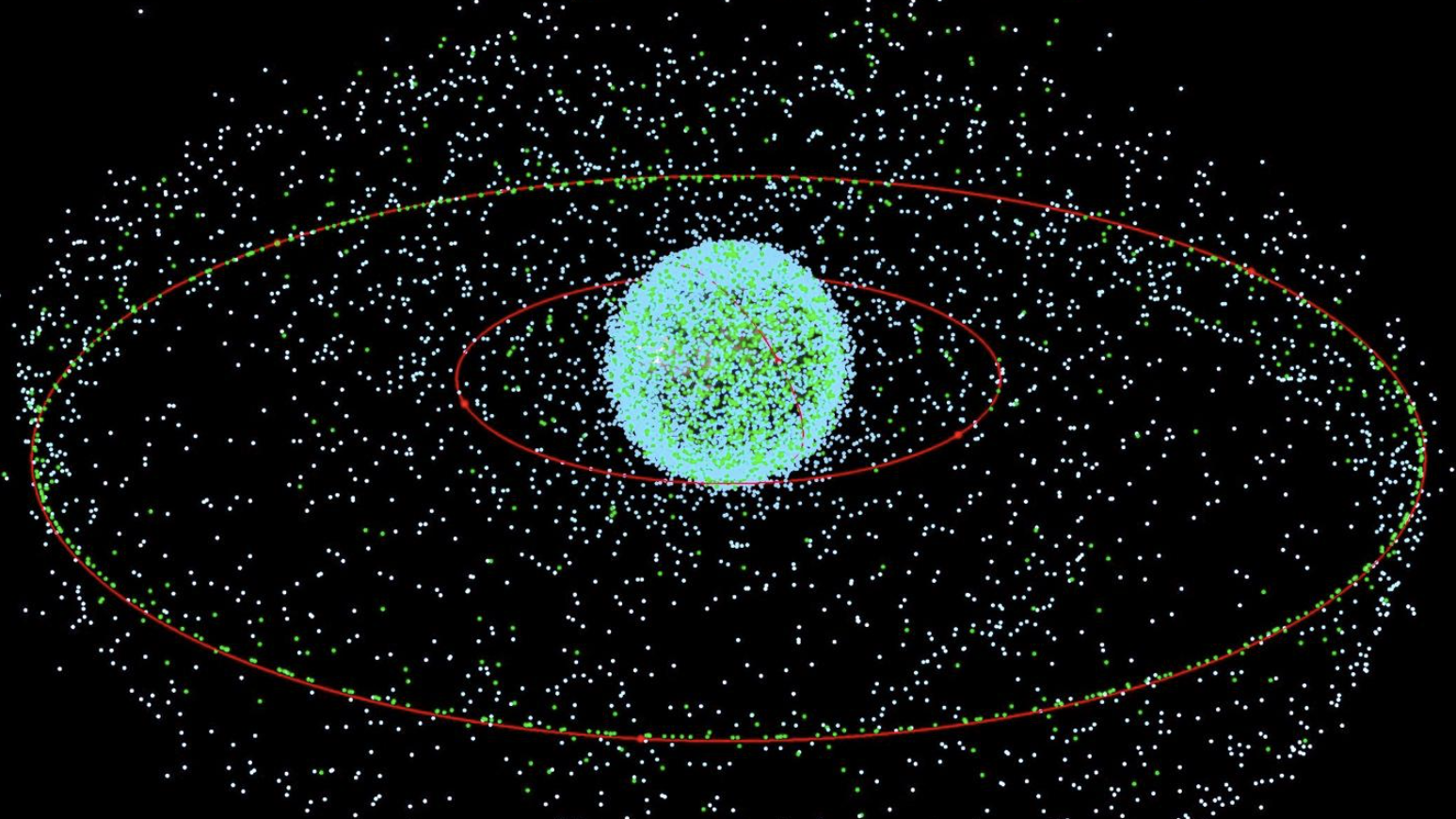
A visualization of over 24,631 tracked objects in orbit. Active satellites imaged in green, inactive satellites imaged in gray. Red orbital rings at 1,000, 10,000, and 36,000 km altitudes. (CSIS Missile Defense Project with data from AGI and U.S. Space Force)
WASHINGTON — While Western military leaders for the past decade have been ringing alarm bells at efforts by Russia and China to develop anti-satellite (ASAT) weapons, the European Defense Fund (EDF) is pursuing what it describes as a defensive capability that could nonetheless target adversary satellites.
The EDF’s latest funding round, based on bids gathered in 2023 and announced on May 16, includes nearly €6.5 million ($7 million) to develop an “Autonomous SSA Bodyguard Onboard Satellite,” nicknamed Bodyguard, that can track threatening enemy birds and, the spare announcement suggests, disable and/or destroy them.
The project is designed “to increase Europe’s independence and superiority in space,” the EDF’s two-page fact sheet says. “In close proximity, it can detect weak-points of the threat satellite and counteract with a robot or laser.” Representatives for the EU did not respond to Breaking Defense’s request for more information about the program as of publication.
Companies from eight European Union countries are involved in the award-winning consortium: two from Belgium; one from Denmark; three from France; two from Finland; one from Greece; one from Latvia; one from Luxembourg; and one from Sweden. The consortium is being coordinated by Toulouse-based Agenium Space, and the project is slated to run for 36 months.
The fact sheet does not indicate the intended orbit for Bodyguard.
It is no surprise to find French firms playing a lead role in the new EDF Bodyguard project, given that Paris already has a similar effort in the works — with then-French Defense Minister Florence Parley announcing in 2019 a plan to develop laser-carrying satellites that could shoot back at hostile birds.
A demonstration project, called YODA, for Yeux en Orbite pour un Démonstrateur Agile, will involve two nano-satellites each weighing 10 to 20 kilograms. The nano-sats will monitor Russian and Chinese satellites in geosynchronous Earth orbit (GEO). Originally expected to launch in 2023, the French Defense Ministry is now looking at 2025. However, according to a May 16 article in European Spaceflight, French Air and Space Force Commander General Philippe Adam told reporters on May 14 he’s worried that the long-running delay in development of the Ariane 6 rocket will delay their launch further.
In addition, the French government’s military programming law covering 2024 to 2030 lays out plans for a larger successor to YODA, called EGIDE (which translates to aegis), to be launched circa 2030. It’s on-board laser is being developed under a project called “FLAMHE” (flame). The document, however, provides no more details on either program.
European nations in general, and the European Union (EU) as an organization, traditionally have been committed to preventing an arms race in space, and further are strong advocates in various United Nations fora for the creation of norms of behavior in space both to avoid orbital mishaps and reduce risks of conflict. However, the EU’s first-ever common strategy for defense of space assets, approved in November 2023, called on the 27 member nations to beef up both awareness of space threats and their capabilities to respond if necessary.
Bodyguard follows a previous EDF project to demonstrate a “stealthy” SSA satellite to keep tabs on adversary satellites in the GEO belt — home to traditional telecommunications satellites and US missile warning birds. That project, called NAUCRATES, is described in a fact sheet on the project’s inclusion in the EDF’s 2021 round as a “Microsatellite for Geostationary Orbit Surveillance and Intelligence” [PDF] and was funded at €4 million ($4.35 million), plus another €1 million ($1.09 million) in national funds.
NAUCRATES “will design and demonstrate a microsatellite with less than 100 [kilogram] mass, positioned in a stable orbit outside the GEO belt, as an in orbit optical sensor with the capability to approach other objects in GEO to take centimeter level resolution images. The NAUCRATES satellite, with an envisaged 3 to 5 years lifespan, will feature a stealth design not to be visible by ground radars, telescopes or SIGINT [signals intelligence] and will host an optical telescope using special infrared for images transmission to minimize eavesdropping possibilities,” the fact sheet says.
NAUCRATES is being developed by a consortium of 11 companies from Italy, the Netherlands, Portugal and Spain, led by Italian company On-Air Consulting & Solutions.
According to an April 9 announcement by one of the participating firms, Amsterdam-based Celestia TTI, the project recently passed critical design review and will be delivered by the end of 2025.
AAC Clyde Space, another consortium member based in Sweden, in a Jan. 26, 2023, press release noted that the satellite is slated to be launched on an Ariane 6 rocket.
